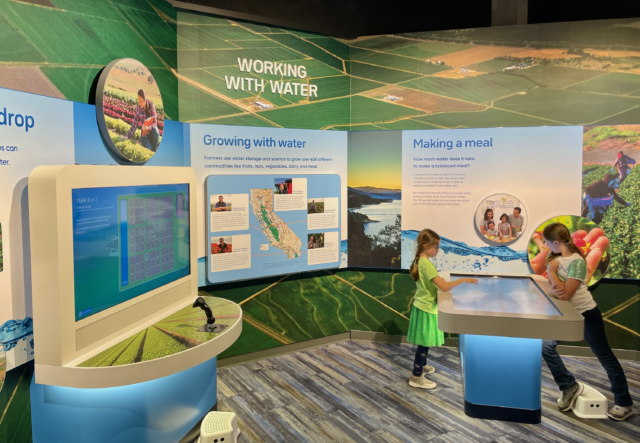Cultivate California’s exhibits tell the story of Sacramento’s Museum of Science and Curiosity
Since Sacramento’s acclaimed Museum of Science and Curiosity (MOSAC) opened in November 2021, more than 331,000 visitors have toured the facility, which features dozens of interactive exhibits on topics such as health care, nature, space exploration and water.

A popular MOSAC section is the Water Challenge Exhibit, which includes three interactive displays sponsored by Cultivate California and its nonprofit parent organization the California Farm Water Coalition, that illustrate how farmers are working hard to use less water.
Two sisters who recently visited MOSAC said they enjoyed the exhibits and the older one said she’d learned something as well.
“I learned that water is very important and that we need water to grow food for people and to feed the animals we’re going to eat,” said 9-year-old Lyla Frith. Her sister, Kaylyn, 7, enjoyed the exhibits on her own level, saying, “I liked it a lot. The games were fun.”
Both girls worked hard on the interactive exhibits to properly irrigate the fields without running out of water and to create their menus for the day, learning how much water was needed to grow the foods and how much nutritional value they contained in the process. In both cases, the game suggested they eat more vegetables.
Making science fun is one of the ways Cultivate California strives to educate Californians about the vital link between farms and ranches and their water supplies, and how the ag community is working hard to grow even more food and fiber while using less water, said Farm Water Coalition Executive Director Mike Wade.
“Our water exhibits bring home the fact that water is essential to grow our food and that California farmers are leading the world in conserving it,” Wade said. “It’s important that everyone know that farmers are using water in an efficient manner and that as consumers, we all depend on farmers.”
Jacob DeBoer, with American AgCredit, said creating innovative ways to educate Californians about the importance of California agriculture is why Farm Credit organizations serving the state’s farmers and ranchers are contributing $100,000 to Cultivate California this year.
“Firmly rooted in American AgCredit’s core values is an unwavering commitment to the communities where we work and live,” DeBoer said. “The MOSAC exhibit does such a great job of educating California consumers on how vital water is in growing the food that feeds our families, and how farmers are always aiming to optimize their water usage to ensure they’re being good stewards of our land.”
Kevin Ralph, AgWest Farm Credit’s California President, agreed.
“Providing accurate information about California agriculture to our state’s mainly urban population is critically important, and every year Cultivate California finds new creative ways to reach people online and get them to engage with the content,” Ralph said. “Farm Credit looks forward to continuing to help them spread the good news about the state’s farms and ranches.”
Ag West Farm Credit, American AgCredit, and CoBank, Colusa Glenn Farm Credit, Fresno Madera Farm Credit, Golden State Farm Credit and Yosemite Farm Credit have sponsored Cultivate California since its inception in 2015. The three organizations are part of the nationwide Farm Credit System, the largest provider of credit to U.S. agriculture.
Of course, the MOSAC exhibit is just one part of Cultivate California’s toolkit. The bigger part of their outreach is via paid advertising on social media channels.
“There are two facets to what we do. The first is to get their attention, and that’s with imagery and food facts, recipes, information about which regions grow different products, and what’s in season,” Wade said.
“That helps get their attention, then we tailor the rest of the message about the importance of water to bring food to consumers and the value of California production over imports where we have less control over how commodities are grown. We get their attention and then deliver the message about why California is such an important ag state.”
He said the digital campaign reached about 10 million people in 2023 and resulted in over 165,000 people engaging with the material through likes, comments and shares. To reach an even broader audience, the campaign is branching out into social media platforms that cater to younger audiences.
“None of this would be possible without the ongoing support of the Farm Credit system,” Wade said. “Farm Credit is among our most generous supporters, allowing us to drive our messaging the way we intended.”
###
About Farm Credit:
AgWest Farm Credit, American AgCredit, CoBank, Colusa-Glenn Farm Credit, Fresno Madera Farm Credit, Golden State Farm Credit and Yosemite Farm Credit are cooperatively owned lending institutions providing agriculture and rural communities with a dependable source of credit. For more than 100 years, the Farm Credit System has specialized in financing farmers, ranchers, farmer-owned cooperatives, rural utilities and agribusinesses. Farm Credit offers a broad range of loan products and financial services, including long-term real estate loans, operating lines of credit, equipment and facility loans, cash management and appraisal and leasing services…everything a “growing” business needs. For more information, visit www.farmcreditalliance.com
About Cultivate California:
Cultivate California is an industry-supported program crafted to help consumers make the connection between farm water and their food supply. Cultivate California helps people see that California farms provide a healthy, safe, affordable and diverse food supply, that they are among the most water-efficient farms in the world, and that California farmers produce many food crops that cannot be commercially grown in other parts of the U.S.






